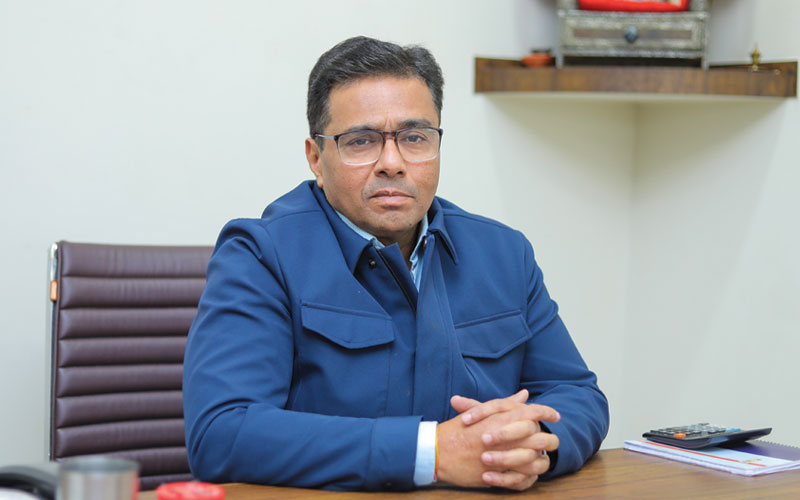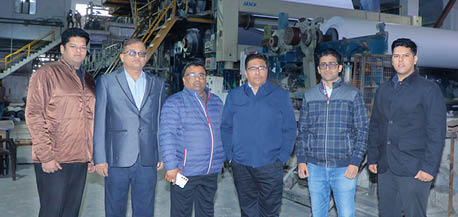In an exclusive interview with Paper Mart, Mr. Amit Mittal Founder and MD, Chandpur Paper, outlined the company’s strategy to scale its presence in the packaging paper and board industry through sustainability, product innovation, and global market expansion. Specialising in MG poster and chromo (C1S) papers, Chandpur Paper serves diverse applications from FMCG to e-commerce, with strategic investments in capacity, technology, and eco-friendly manufacturing to become a competitive global supplier of sustainable packaging solutions.

Paper Mart: Could you begin by giving us an overview of your packaging paper and board operations – including your production capacity, facility locations, and manufacturing setup?
Amit Mittal: We have a well-located plant in Chandpur, Uttar Pradesh, with a current production capacity of approximately 120 metric tons per day. We specialize in MG posters and chromo (C1S) paper for various packaging and printing needs. Our units are adequately geared with enhanced equipment and strict quality control to ensure consistency, accuracy, and environmental friendliness. With growing demand for sustainable and efficient packaging solutions, we are aggressively pursuing capacity augmentation and new production line expansion. These are in line with our vision of long-term development, innovation, and commitment to sustainability.
Watch: In Pursuit of Lesser Water Footprint
PM: Please walk us through your current product portfolio. What grades, GSM ranges, and end-use applications do you cater to, and are there any specialty packaging paper and board products you offer?
AM: Our portfolio includes MG poster paper and chromo (C1S) paper, which are retailed primarily in GSM ranges of 35 to 70. Our paper grades find applications in FMCG packaging, labeling, commercial print, PE lamination, and flexible packaging segments. Keeping an eye on changing market trends and growing environmental pressures, we are also producing value-added and specialty grades. Others among such solutions include food-contact packaging solutions, e-commerce shipping packaging solutions, and biodegradable paper bags as a green alternative. Our emphasis continues to be on the creation of ecologically sound, functional, and high-performance products in accordance with evolving consumer needs and regulation.
PM: Which are your key domestic and international markets? How has your market footprint evolved in the past few years?
AM: We have our presence in major industrial clusters of India, i.e., Maharashtra, Gujarat, Delhi NCR, Punjab, and the southern states. We have stepped up our presence internationally in Southeast Asia, the Middle East, and Africa on the basis of our guarantee of consistent quality, prompt delivery, and customer-focused service. We serve clients across industries such as retail, publishing, and food packaging. These consumers reaffirm their confidence in our offerings and services. As part of our master strategy, we remain committed to increasing our export visibility with high-quality guarantees and market responsiveness.

Our paper grades find applications in FMCG packaging, labeling, commercial print, PE lamination, and flexible packaging segments. Keeping an eye on changing market trends and growing environmental pressures, we are also producing value-added and specialty grades.
PM: Sustainability is becoming a cornerstone of packaging. What steps have you taken to integrate environmentally responsible practices into your manufacturing and sourcing?
AM: Sustainability is the core part of our business. We employ certified, responsibly managed raw material suppliers, since most of our raw material in itself is recyclable waste, supporting a circular economy. Our manufacturing facility features up-to-date closed-loop water recycling facilities, energy-efficient production processes, and waste heat recovery systems. We have also introduced low-plastic secondary packing in an effort to further reduce environmental effects. With continued updates in technology and process optimization, we are striving towards minimizing our carbon footprint and being responsible for environmentally friendly production. Our drive towards sustainability is imprinted in every phase of production, up to international best practices and future industry standards.
PM: How has demand for packaging paper and board evolved post-COVID and amid growing e-commerce and FMCG consumption? Which segments are currently driving the most growth for you?
AM: Sustained growth in demand has been observed post-pandemic, driven by the high level of growth of e-commerce as well as industry-wide movement towards sustainable packaging, driven primarily through the FMCG and QSR channels. As brands shed plastic packaging, a quicker adoption of paper-based products has followed. Demand for our product range has risen immensely from domestic market converters and export-driven corrugators catering to both domestic markets and export-based FMCG customers. The trend will be continued as sustainability remains a packaging innovation driver and as international consumer decision-making continues to move even more towards green solutions.

Sustained growth in demand has been observed post-pandemic, driven by the high level of growth of e-commerce as well as industry-wide movement towards sustainable packaging, driven primarily through the FMCG and QSR channels. As brands shed plastic packaging, a quicker adoption of paper-based products has followed.
PM: According to recent global market data, the packaging paper and board market is projected to grow steadily through 2033. How are you positioning your business to tap into this rising global demand?
AM: We are increasingly building our market position with targeted capacity building, diversification, and a robust export-driven strategy. Our strategy is to acquire significant foreign certifications, increase technical prowess, and drive product innovation to take the lead with evolving international standards. Through R&D investment and an expanding global presence, we aim to align our products with evolving packaging market needs. We want to be a known and competitive global supplier of sustainable paper and board products, bringing value in terms of quality, compliance, and innovation-driven product development in support of evolving consumer and regulatory requirements.
PM: What are some of the most significant technological upgrades or process improvements you’ve made recently in your mills to enhance quality, reduce waste, or optimize energy usage?

AM: We installed new technology paper machines and fiber lines recently to direct quality as well as operational efficiency. Real-time quality monitoring systems were installed to ensure batch-to-batch uniformity and reduce profile deviations. In the energy area, we installed high-efficiency motors and a digitalized steam management system, which reduces power consumption on a significant scale. Not only do they improve our capability to produce, but they also align with our more general sustainability goals. By investing in state-of-the-art automation and power efficiency, we demonstrate our commitment to continuing with sustainable manufacturing and producing high-performance paper products with the smallest environmental impact possible.

Raw material and energy price uncertainty continue to be the greatest challenges for our company. In reaction to this, we have diversified our suppliers and are aggressively pursuing backward integration to achieve more cost control and supply guarantees.
PM: Are you seeing a shift in customer preference toward higher-strength or lightweight packaging paper and board variants? How are you balancing performance with cost-efficiency in product development?
AM: Yes, customers today are increasingly cost-sensitive and more environmentally conscious, driving demand for high-strength paper. R&D researchers in our company are currently developing high-performance grades with optimal fiber structures without compromising on strength or performance. These products conserve packaging weight, save cost, and allow customers to publicize their environmental initiatives. Synchronizing product development with market need, we are developing packaging solutions that are not only efficient but also green. Our focus is on providing a balance between performance, reliability, and cost savings that enables converters and manufacturers to keep up with evolving industry needs and customer demand.
PM: What are the major challenges you currently face as a packaging paper and board manufacturer– be it raw material volatility, energy costs, logistics, or regulatory changes? How are you navigating them?
AM: Raw material and energy price uncertainty continue to be our greatest challenges for our company. In reaction to this, we have diversified our suppliers and are aggressively pursuing backward integration to achieve more cost control and supply guarantees. More and more frequently, the high cost of logistics and shifting sustainability expectations make realignment a common necessity. These are added to by our increased measures in compliance and placing heavy focus on open communication with the stakeholders. Our strategy is balanced between operating flexibility and forward planning to allow us to be adaptable and resilient in a constantly changing business landscape. By remaining cautious yet continuously improving, we aim to stay competitive in the long term and ensure sustainable growth.
Also Read: Ruchira Papers Propels Sustainability Through Agro-Based White Packaging Paper
PM: Looking ahead, what’s your strategic roadmap – capacity expansion, backward integration, export push, product diversification? How do you envision your mill’s role in the global packaging paper and board value chain in the next 5 years?
AM: Our five-year plan is based on increasing production capacity, consolidating exports, and diversification into food-grade and specialty papers divisions. All these are directed towards our long-term objective of creating Chandpur Paper as a globally accepted brand that excels in innovation, excellence, and sustainable production. With added depth in process efficiency and products, we will address evolving industry demands and regulatory compliance. We aspire to be a trusted global partner in packaging, driving sustainable and high-performance solutions.

We installed new technology paper machines and fiber lines recently to direct quality as well as operational efficiency. Real-time quality monitoring systems were installed to ensure batch-to-batch uniformity and reduce profile deviations.



